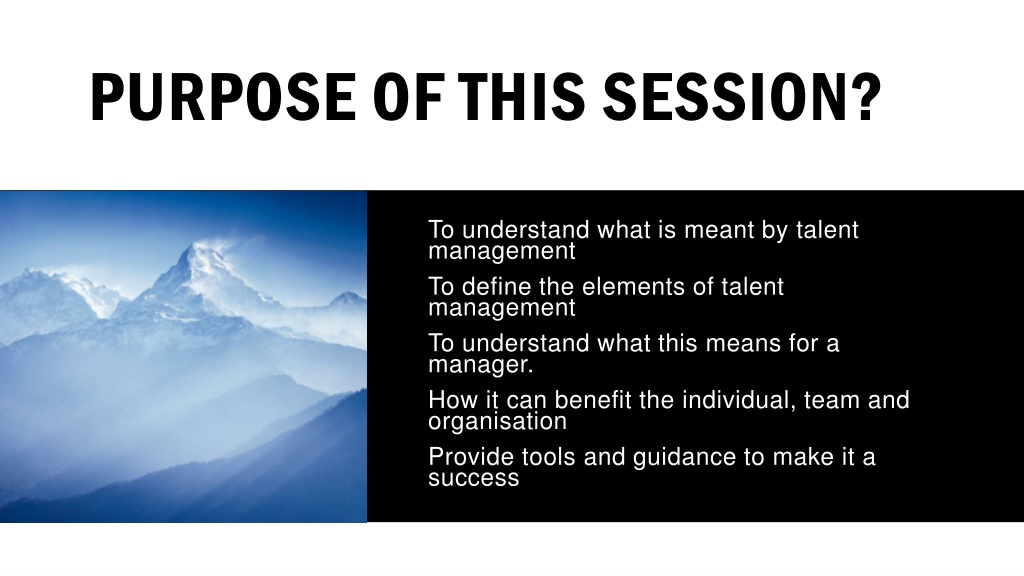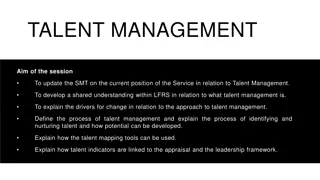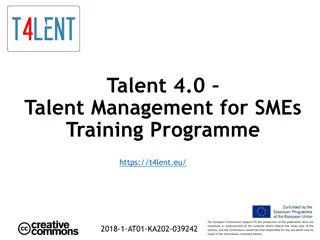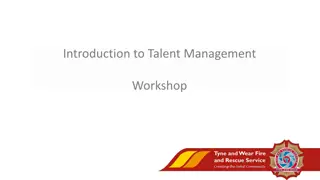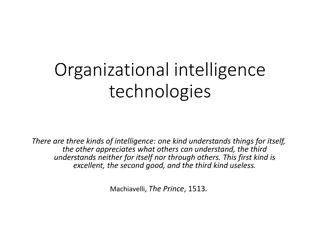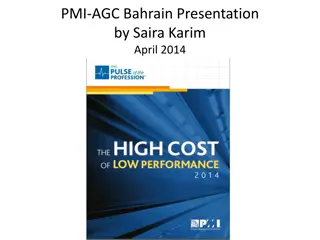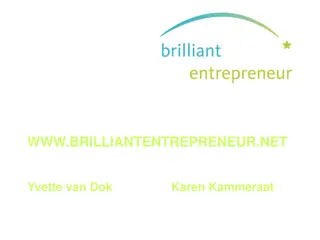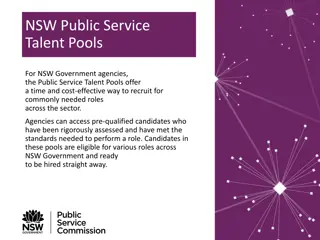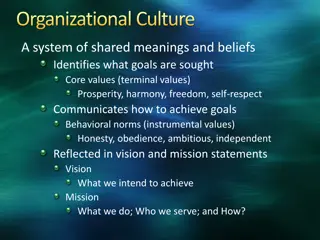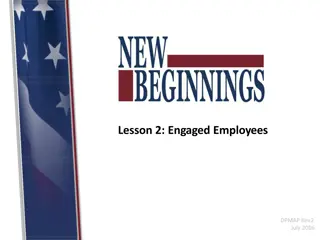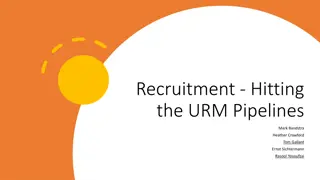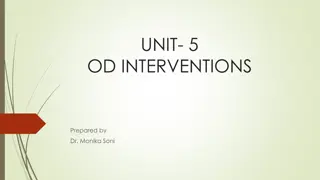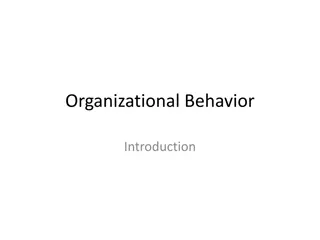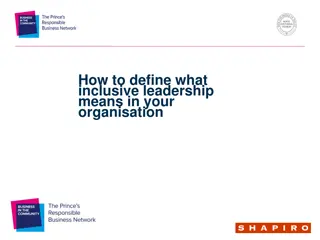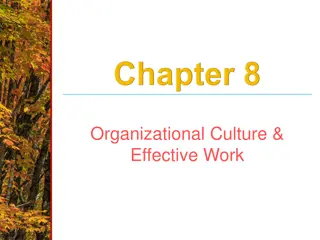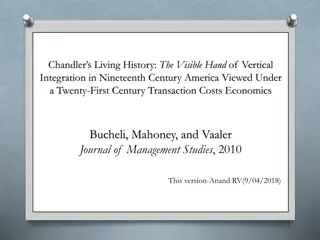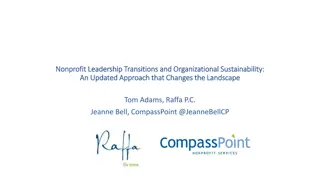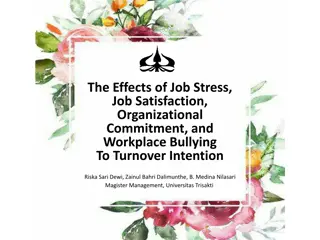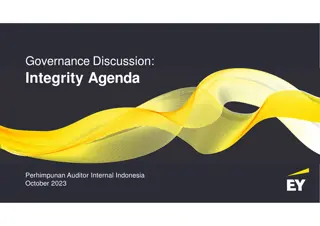Understanding Talent Management for Organizational Success
In this session, we delve into the concept of talent management, exploring its definition, elements, benefits for individuals, teams, and organizations, and its significance for managers. We also discuss ways to define talent, its relevance to LFRS (Leicestershire Fire and Rescue Service), and the practical aspects of talent identification, nurturing, and retention. The session emphasizes the importance of talent spotting, nurturing identified talent, and leveraging it through structured support and development plans.
- Talent Management
- Organizational Success
- Talent Identification
- Talent Development
- Managerial Benefits
Download Presentation

Please find below an Image/Link to download the presentation.
The content on the website is provided AS IS for your information and personal use only. It may not be sold, licensed, or shared on other websites without obtaining consent from the author. Download presentation by click this link. If you encounter any issues during the download, it is possible that the publisher has removed the file from their server.
E N D
Presentation Transcript
PURPOSE OF THIS SESSION? To understand what is meant by talent management To define the elements of talent management To understand what this means for a manager. How it can benefit the individual, team and organisation Provide tools and guidance to make it a success
HOW DO WE DEFINE TALENT? Talent management aims to consider the individual in relation to the Service using two factors, one which takes into account performance to date; the other to assess potential.
WHAT IS TALENT MANAGEMENT TO LFRS Talent Management is about ensuring LFRS: Has people with the right capabilities, commitment and behaviour to deliver current and future organisational success Provides access to opportunities and stretch development that enable people to achieve their potential. Is able to identify and apply a consistent measure of individuals potential which is open and transparent
SO WHAT?- WHY USE TALENT MANAGEMENT Potential for a change within roles Employee engagement and inclusion Promotes Diverse Workforce Reduced costs.
ELEMENTS OF TALENT MANAGEMENT Define it Attract and recruit it Nurture it Retain it
HOW DO YOU THINK WE CAN IDENTIFY OUR OWN TALENT? Within our own workforce talent can be identified in formal ways: - Annual appraisal - Lifetime/Career conversation - Through observation/Talent spotting
TALENT SPOTTING The way individuals: Organise themselves. Deliver projects. Stand out positively. Are viewed by peers. Exert influence, Build relationships, maintain high performance themselves and within their team.
NURTURING TALENT Once identified- what then? There needs to be a plan of support/development. That plan needs to enable the individual to reach their maximum potential and bridge the gap. This could include a combination of informal and formal learning: Coaching and mentoring Job rotation/multi-skilling Secondments Project work Deputising
RETAIN TALENT Currently we have a good retention of staff Building strong working relationships. Creating an Organisational Culture built on the STRIVE Values. Demonstrate the STRIVE behaviours Flexibility and good work life balance Having a positive working environments which are also interesting.
TALENT IN LEADERSHIP ROLES Leadership Framework Effective leadership is about developing a vision for the future, as well as understanding the current needs of LFRS. LFRS recognises outstanding leaders as: Those who engage with others, energize them to overcome barriers, build confidence and trust and use coaching and support to deliver innovation, successful performance and great community service. Leaders should be willing to challenge poor behavior wherever it occurs. There are challenges in delivering this in a hybrid working environment.
TALENT IN LEADERSHIP ROLES Talent Indicators (link the LFRS Performance Appraisal and the Leadership Framework) describes the behaviours demonstrated in the identification of talent: Leading yourself Leading Others Leading the Function Leading the Service
Leading Yourself Demonstrates pride and passion in the Service. Seeks to develop and innovate. Actively listens and is approachable. Makes the best possible use of time at work. Is self-reflective and is aware of personal impact on others. Leading Others Highly developed area of expertise. Takes responsibility for decision making. Delegates effectively, developing confidence in others. People and outcome focused. Challenges negativity where it is a threat to improvement. Leadership Framework Leading the Service Understands what the Service is trying to achieve. Broad understanding of the internal and external influences affecting the Service Develops and sustains collaborative relationships with internal and external stakeholders Flexible and open to new ways of working. Encourages others to make decisions. Leading the Function Broad understanding of the Service. Monitors the performance, quality and completion of goals. Builds constructive relationships to deliver shared goals. Enters into dialogue rather than conflict. Solves problems creatively from a position of enquiry.
ASSESSING TALENT The Talent Mapping tool/grid can be used to: Inform the conversation in relation to talent. Used by individuals to self evaluate their progress Rank individuals in relation to their talent.
ASSESSING TALENT Ranking: Exceeding Expectations Emerging Talent, Advancing Talent, Ready Now, High Potential Meeting Expectations Key contributors Partially meeting expectations Improvement required: Not reaching potential or developing in role
PART 2- CAREER/LIFETIME CONVERSATION- WHY ARE THESE IMPORTANT? Good conversations ensure greater mutual understanding between people, more opportunities to give praise, better clarity of focus and increased engagement.
TALENT INDICATORS Capability Committment Behaviours
YOUR ROLES AND RESPONSIBILITIES Talk about TM with staff member (use of the TM grid) Commit to time and date Make sure you have prepared Ownership- two way Support and encourage
QUALITY CONVERSATIONS- WHAT DO THESE LOOK LIKE TO YOU? Giving it the time it deserves Being more person and career centred Clarity about performance/potential People need to understand expectations People need to feel connected to the organization. Individual needs v organisations requirement
QUALITY CONVERSATIONS Its about: Building relationships Understanding your people Understanding their aspirations Understanding their career and life stages
QUALITY CONVERSATIONS- HOW TO ACHIEVE THIS Appreciating and valuing difference- think about your approach to the conversation Performance- balance what they do, with how they do things; don t just use values, use behaviours also. Practice Potential and readiness- do they have the capacity to develop in the future
PART 3- GIVING FEEDBACK Having an honest conversation Insight into their behaviours and how it effects others Enable people to make better choices- future and essential to learning,
GIVING FEEDBACK-USE OF EVIDENCE Focus on what you see and hear the person doing or saying Based your evidence on observed behaviour Use quotes and feedback where possible
GIVING FEEDBACK- JOHARI WINDOW Insert image
RESPONSES TO FEEDBACK S- Surprise A- Annoyance R- rationalization A- Acceptance
GIVING FEEDBACK- SOURCES OF ERROR Halo and Horns Central tendency Leniency or harshness Similarity/attractiveness First impressions; stereotyping Recency
USEFUL MODELS FOR GIVING FEEDBACK- BEER Tell Approach B- Behaviour- this is what I saw E- Effect- this is the effect it had on people E- Expectations- this is what I expect from you R- Result- this will be the result if you do/do not change
USEFUL MODELS FOR GIVING FEEDBACK- BEER Ask Approach B- Behaviour- this is what I saw E- Effect- What effect do you think this has? E- Expectations- What do you think I expect? R- Result- What result would that give us if your changed that behaviour?
RECOGNISE DIFFERENCES IN YOUR TEAM? Content? Ambitious? Newly Qualified? Disengaged? Disgruntled? Master of illusion? Self promoting/self-critical
FEEDBACK SUMMARY Think About how you want the feedback to land BEER may be blunt/specific- there are other frameworks available Bigger issues will need more time Consider what might be the iceberg Plan your feedback carefully
FEEDBACK TIPS Be clear Make it specific- give examples Own the feedback Be timely Vary your approach according to receiver Don t overload receiver Don t keep repeating the same message Check your feedback has been understood
WHAT DO WE NEED FROM YOU? Engagement with the process Use the lifetime/career conversation tool Have open and honest conversations Reflect on how you are perceived as a manager Understand your people and their differences. Plan, Prepare and Practice
WHAT WILL WE SEE? Improved staff engagement Improved job satisfaction A proactive approach to succession/workforce planning Retention of staff/experience/skills Diverse/flexible workforce
GOLDEN RULES ABOUT COMMITMENT, CAPABILITY AND BEHAVIOURS They are constantly changing They are shaped by the employment experience Heavily influenced by life outside of work and changing work priorities all of which means they need re-visiting regularly throughout the year.
